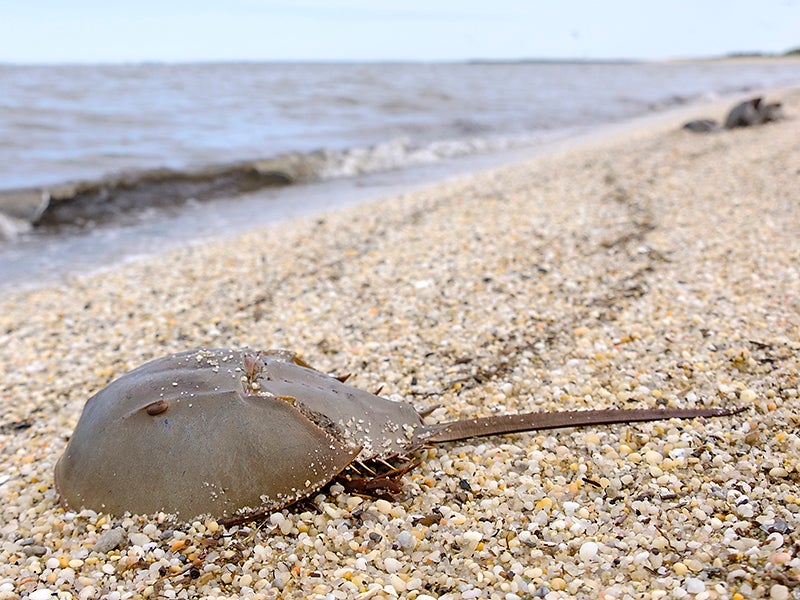A Pathway to End the Medical Harvest of Horseshoe Crabs
The biomedical industry harvests massive quantities of horseshoe crabs every year, threatening a number of migratory birds that rely on the crabs as a food source. But synthetic alternatives are becoming available.
For more than 400 million years—since before dinosaurs roamed the Earth—horseshoe crabs have inhabited the world’s oceans. Every spring under the full and new moon, they shuffle onto the beach, ten legs lumbering under an oversized shell and a spiny tail trailing in the sand. Once on the beach, females each lay thousands of eggs in a single night—and upwards of 80,000 eggs per year—ensuring that we can share the planet with another generation of this ancient species.
But horseshoe crabs are far more than a prehistoric curiosity. They are a keystone species essential to the modern-day ecosystems where they live. When allowed to thrive, they lay a superabundance of eggs, enough to sustain their population and provide an irreplaceable food source to many other species. One of these species—the red knot shorebird—undertakes an annual, 19,000-mile round-trip migration that can span from the southern tip of South America to its breeding grounds in the Arctic. This epic journey coincides with the horseshoe crab spawning season, and most red knots aim for a rest stop on the U.S. Atlantic coast specifically to feast on nutritious crab eggs. With their energy restored, red knots have a better chance of completing their journey and breeding successfully. And horseshoe crabs aren’t important just to red knots—many other birds and multiple fish species also rely heavily on the crabs’ eggs as a critical food source.
In the past several decades, horseshoe crabs have been severely overharvested, drastically depleting their population. The effect on species that rely on horseshoe crabs has been equally catastrophic—red knots are now listed as “threatened” under the Endangered Species Act. For two years, we have worked with New Jersey Audubon and Defenders of Wildlife to limit the harvest of horseshoe crabs for use as bait in other fisheries. But another threat to horseshoe crabs continues to grow.
Every year, the biomedical industry harvests massive quantities of horseshoe crabs from the Atlantic coast—more than 900,000 in 2022 alone. The horseshoe crabs are transported to laboratories where they are strapped down, a needle is inserted near their hearts, and up to half of their bright blue blood drains into vials below. Ideally, the horseshoe crabs are then returned to the ocean, but an untold number do not survive the procedure, and the long-term effects on surviving crabs are poorly understood. The blood is processed into a substance that detects contamination in products ranging from vaccines to joint replacements. If you have ever received an injection or implant, you have probably encountered a product that was tested with horseshoe crab blood.
The good news is that several companies now offer synthetic alternatives that are equally effective at detecting contamination and are manufactured without exploiting horseshoe crabs. Industry has been slow to adopt these alternatives, partly because, under the current regulatory framework, companies have to jump through extra hoops to use them. There is no reason the synthetic alternatives should be harder to use—many other countries have already approved them, and one U.S. company (Eli Lilly) has done the extra work to begin using them, demonstrating that they are safe and viable.
Recently, the United States Pharmacopeia (USP), which sets standards for medical safety testing, announced it will allow companies to use the synthetic alternatives under the same terms as the substance created from horseshoe crab blood. This standard will enable a much faster transition toward synthetic alternatives and give horseshoe crabs an urgently needed reprieve.
USP’s decision is a critical step toward restoring the Atlantic coast as an abundant stopover site for red knots and other migratory birds as they fly across the globe. With a little help, horseshoe crabs can keep emerging from the ocean every spring and continue their ancient ritual for many years to come.
Originally published on January 11, 2024. Updated with news of the finalized USP synthetic alternatives standard.
The Biodiversity Defense Program fights to reshape our relationship to lands, water, and wildlife everywhere by confronting the major drivers of the decline in nature, including habitat destruction and over-exploitation of wildlife.
